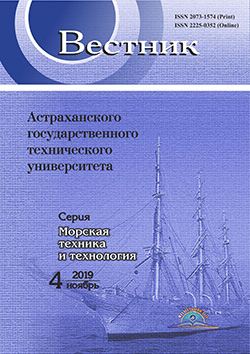Russian Federation
Russian Federation
Russian Federation
CSCSTI 44.31
CSCSTI 45.01
CSCSTI 55.42
CSCSTI 55.45
CSCSTI 73.34
The paper highlights the problem of the small trawlers with great block coefficient, despite their optimal architectural and constructive characteristics for fishing in the Baltic Sea. it has been stated that when the expected speeds of the vessel are reached, their towing resistance increases greatly and a significant trim appears on the bow. To clarify the reasons there have been carried out the additional studies of the relation between changes in the landing gear and the towing resistance of the vessel in different modes of movement in order to select the optimum trim for the vessel. The test program included towing tests of a ship model in the speed range 4-12 knots of a full-scale ship with one displacement value and different initial trim values at the stern. It has been inferred that at the stage of designing small fishing vessels (up to 24 meters long) it is advisa-ble to limit the maximum speed to 11 knots, which corresponds to a Froude number ≈ 0.4. Further increase in the speed of the vessel will result in rising a residual resistance coefficient considerably, which will lead to a disproportionate increase in the required power. The residual resistance coeffi-cient of the hull is minimal, provided that the vessel moves at the calculated speed with an even keel, while the optimum angle of the initial trim makes 1.0-2.5 degrees aft. Improper longitudinal balance of small fishing vessels with a large completeness of contours can lead to an increase in re-sidual resistance of up to 30%. The experimental results can be applied to all small fishing vessels with similar block coefficients. It has been recommended to conduct the full-scale tests with differ-ent ship models having various block coefficients in order to define the dependence between the completeness of the vessel and the value of drawdown.
Froude number, designed trim, small fishing vessel, great hull configuration, residual resistance, experimental studies
1. Chureev E. A. Nesootvetstvie moshchnostej promyslovogo flota i beregovoj infrastruktury v Kaliningrad-skoj oblasti. Morskaya tekhnika i tekhnologii. Bezopasnost' morskoj industrii [Inconsistency of fishing fleet ca-pacities and coastal infrastructure in Kaliningrad region. Marine engineering and technology. Marine Safety]. Materialy IV Mezhdunarodnoj nauchnoj konferencii (Kaliningrad, 22-28 maya 2016 g.). Kaliningrad, Izd-vo BGARF, 2016. 1648 p. Pp. 221-226.
2. Chureev E. A. K voprosu o vybore arhitekturno-konstruktivnogo tipa malogo rybolovnogo traulera dlya Baltijskogo morya [On problem of choosing architectural and constructive type of small fishing trawler for the Baltic Sea]. Morskie intellektual'nye tekhnologii, 2017, no. 3 (37), vol. 1. 175 p. Pp. 35-38.
3. Chureev E. A. Issledovanie formy obvodov malomernogo rybolovnogo traulera s cel'yu povysheniya ego morekhodnyh kachestv [Studying hull lines of small fishing trawler to increase its seaworthiness]. Morskie intel-lektual'nye tekhnologii, 2018, no. 3-4 (42), pp. 36-43.
4. Spravochnik po teorii korablya. Vol. 1. Gidromekhanika. Soprotivlenie dvizheniyu sudov. Sudovye dvizhiteli [Handbook of ship theory. Vol. 1. Hydromechanics. Resistance to ship propulsion. Ship propulsion gear]. Pod redakciej Ya. I. Vojtkunskogo. Leningrad, Sudostroenie Publ., 1985. 768 p.
5. Ivanov V. P. Tekhniko-ekonomicheskie osnovy sozdaniya rybolovnyh sudov: uchebnik [Technical and economic basis for building fishing vessels: textbook]. Kaliningrad, Izd-vo BGARF, 2010. 274 p.
6. Gajkovich A. I. Teoriya proektirovaniya vodoizmeshchayushchih korablej i sudov: monografiya [Theory of design of displacement ships and vessels: monograph]. Saint-Petersburg, Morintekh Publ., 2014. 872 p.

















